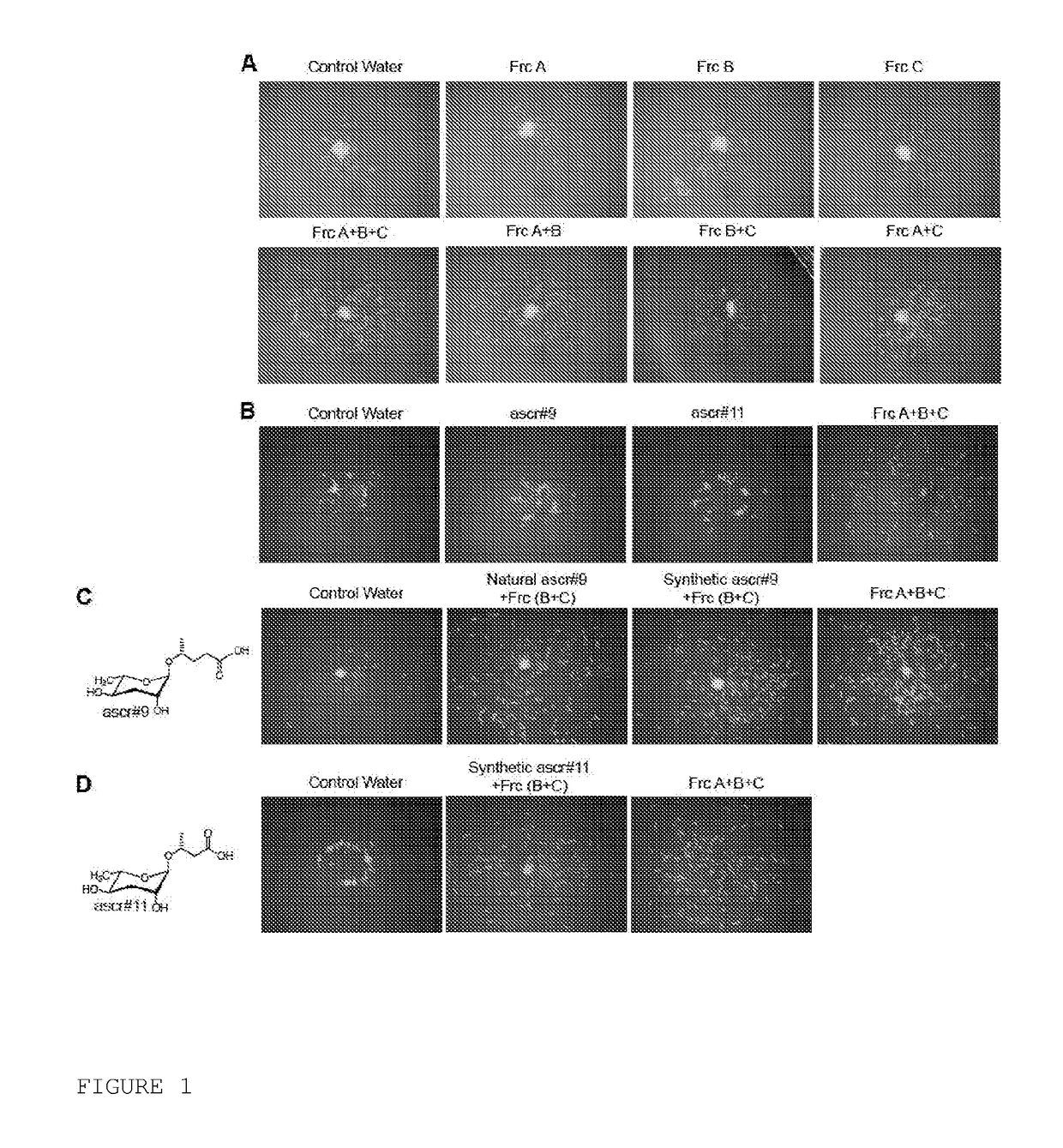Nematode dispersant composition and method
a technology of nematodes and compositions, applied in the direction of biochemical apparatus and processes, invertebrate cells, biocide, etc., can solve the problems of insufficient dispersibility of nematodes, inability to properly find and parasitize plant destructive insects, etc., to improve the potential for encounters with insect hosts and insect mortality, the effect of improving the rate of ra
- Summary
- Abstract
- Description
- Claims
- Application Information
AI Technical Summary
Benefits of technology
Problems solved by technology
Method used
Image
Examples
example 1
Activity Guided Purification of Nematode Dispersal Activity
[0036]The dispersal assay for the activity guided purification in FIG. 1 used S. feltiae IJs that were washed with MILLI-Q water three times and incubated in 6 cm petri dishes for 36 h with a small amount (4-5 ml) of MILLI-Q water. The following day, nematodes were placed on a 10.7 g / L agar with gel strength 1010 g / cm2 (PhytoTechnology Lab. Shawnee Mission, Kans.). Nematode behavior was assayed on multiple plates with internal plate replicates to rule out the possibility that behavior was affected by plate composition. Approximately 300 IJs in 10 μl water were placed on an agar medium and the test compounds or extracts were placed into 1-2 μl to the nematode suspension. Upon absorption (15-20 min) of the liquid, the freely moving nematodes were video-recorded for 5-10 min. Dispersal behavior is temperature and season dependent. During winter, the assay is effective at RT (22±1° C.). During summer, the assay requires a temper...
example 2
Dispersal Activity
[0045]The dispersal assay for C. elegans was adapted from S. feltiae. Briefly, C. elegans dauer juveniles were washed with MILLI-Q water 3 times and placed into 6 cm petri dishes with a small amount of water and rested overnight. Approximately 200-300 nematodes in 10 μl of water were placed on an agar plate and 2 μl of treatment was added. The liquid culture that produced 60% dauer animals was centrifuged and filtered with a 0.45 μm filter and used as a positive control for dispersal. Thereafter, media were lyophilized and resuspended in MILLI-Q water 5 times and 2 μl to 10 μl of nematode suspension was used for assay. As a negative control, 0.5% E. coli (HB101) was prepared in S-complete, lyophilized and adjusted to the final volume of 0.25% E. coli in the assay. The dispersal behavior was observed for 12-15 min.
[0046]Liquid cultures that induced 60% dauer (2 experiments) and 40% dauer after 67 h of feeding L1s were analyzed using Liquid Chromatography and Mass Sp...
example 3
Beneficial Effects of Epn Dispersant Utilization in Field Application of Nematodes as Biocontrol Agents
[0047]It is anticipated that by using the composition and method according to this invention, the efficacy of nematode biocontrol on preventing plant damage will be increased by between at least about 1-100%, e.g. by 1%, by 2%, by 5%, by 10%, by 20% by, 30%, by 40%, by 50%, by 60%, by 70%, by 80%, by 90%, by 100%.
[0048]In certain embodiments, it is estimated that the pheromone extract treatment increases efficacy of nematodes as a biocontrol between 40% and 60%. The increase is 40-60% in insect mortality.
PUM
| Property | Measurement | Unit |
|---|---|---|
| temperatures | aaaaa | aaaaa |
| weight | aaaaa | aaaaa |
| temperature | aaaaa | aaaaa |
Abstract
Description
Claims
Application Information
 Login to View More
Login to View More - R&D
- Intellectual Property
- Life Sciences
- Materials
- Tech Scout
- Unparalleled Data Quality
- Higher Quality Content
- 60% Fewer Hallucinations
Browse by: Latest US Patents, China's latest patents, Technical Efficacy Thesaurus, Application Domain, Technology Topic, Popular Technical Reports.
© 2025 PatSnap. All rights reserved.Legal|Privacy policy|Modern Slavery Act Transparency Statement|Sitemap|About US| Contact US: help@patsnap.com



